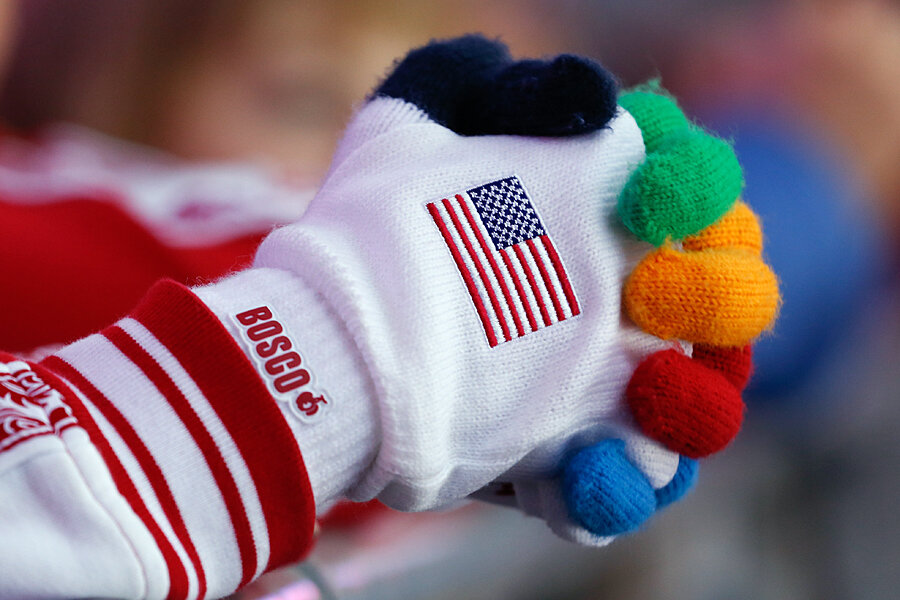School can nix American-flag clothing to ease racial tension, US court says
Loading...
The US Ninth Circuit Court of Appeals in San Francisco ruled Thursday that an assistant principal at Live Oak High School outside San Jose, Calif., acted within the law when he told students wearing American-flag clothing on Cinco de Mayo to remove them from campus because Hispanic students were offended to the point of violence.
The provocative three-judge ruling concerning a majority-Hispanic school that has long struggled with racial and gang tension – the principal counted more than 30 fights a year between rival groups – is in some ways a slam-dunk decision tied directly to a 1969 US Supreme Court ruling that gave wide latitude to school officials to take preemptive action to ensure student safety, even if such actions curbs a student’s free speech rights under the Constitution.
But Thursday’s ruling in a lawsuit brought by three Anglo students also may prompt a Supreme Court look-see. At issue is whether the school district, in the interest of avoiding disruption in the school, overstepped its authority in regulating student speech.
The narrative of what happened on May 5, 2010, at a school Cinco de Mayo festival is fraught with potential unrest and danger at Live Oak. School officials said students wearing American-flag inspired clothing for the school-sanctioned Mexican holiday celebration had sparked racially charged violence the previous year between warring cliques.
At the 2010 celebration, several students wore pronounced US flag clothing that Hispanic students saw as a provocation. “Don’t you like Mexicans?” one of the Anglo students was asked by an angry student.
To ease rising tension on the school’s quad, school officials asked the Anglo students to turn the clothing inside out or to take an excused absence from school.
The appeals court found the evidence proved it was “reasonable for school officials to proceed as though the threat of a potentially violent disturbance was real,” and that the response – the removal of some US flag clothing from campus, with no punishment for the students – was ultimately “tailored to the circumstance.”
In that way, the judges ruled, the school's action did not deprive the three students bringing the lawsuit of their civil rights. The panel made note of the fact that the principal “did not embargo all flag-related clothing.”
The 1969 Tinker v. Des Moines Independent School District decision gave wide leeway to school administrators to curtail students’ free speech if there is reasonable fear that speech could spark disruption. The Tinker decision has also been noted in subsequent court decisions that allow school officials to ban Confederate flag clothing because of the rebel flag’s potentially disruptive nature.
According to the court, Hispanic students at Live Oak interpreted the flag as a provocation. As the unrest spread, school officials jumped in to keep matters from further escalating, the court found.
“When Assistant Principal Miguel Rodriguez told the student to stop using profane language, the student said, ‘But Rodriguez, they are racist. They are being racist. [expletive] them white boys. Let’s [expletive] them up,’ ” the court recounted.
The precedent set when officials react to threats of violence by shutting down speech of peaceful protesters – the so-called “heckler’s veto” – distresses some legal experts, even if Tinker permits it. Moreover, some observers say, the court stuck strictly to Tinker to avoid the hot-button issues of flag symbology and immigration.
“The fact is, in political speech, you get hecklers because political speech riles people up, but that’s not the same as violence,” Trevor Burrus, a research fellow at the Cato Institute’s Center for Constitutional Studies in Washington, told the Monitor last year.
Commentators weren’t ready to let the Ninth Circuit court, one of the more liberal US appeals courts, off the hook for going along with what they see as the slippery slope of cultural appeasement.
“Instead of preventing racist Mexican violence, the school took the predictable course of outlawing America,” and the court subsequently “approved a heckler’s veto for racist anti-American Mexicans in California,” writes Daniel Greenfield, in the conservative Front Page Mag.
Even law experts who concede that the Ninth Circuit’s decision may be justifiable fret about its implications.
“Somehow we’ve reached the point that students can’t safely display the American flag in an American school because of a fear that another student will attack them for it,” writes California law professor Eugene Volokh, on the Washington Post’s "Volokh Conspiracy" blog. “When thuggery pays, the result is more thuggery. Is that the education we want our students to be getting?”
William Becker, a lawyer representing the three unnamed students who brought the lawsuit, said he will appeal the decision all the way to the US Supreme Court, if necessary.
"The Ninth Circuit upheld the rights of Mexican students celebrating a holiday of another country over US students proudly supporting this country," Mr. Becker told The Associated Press.








